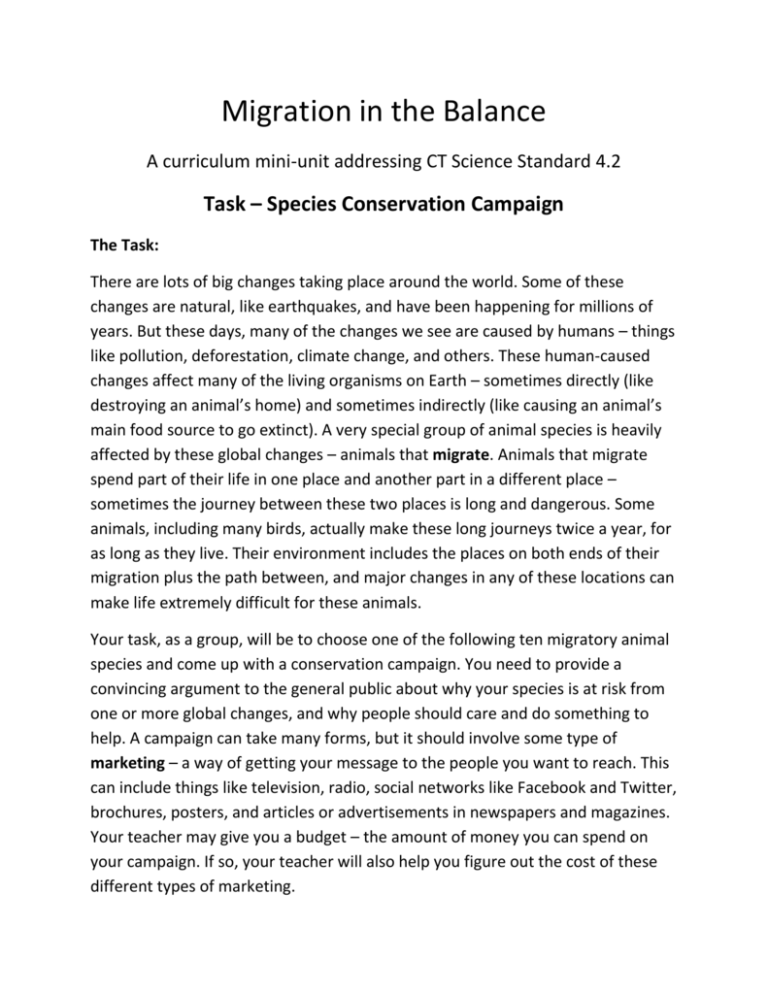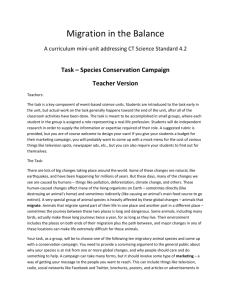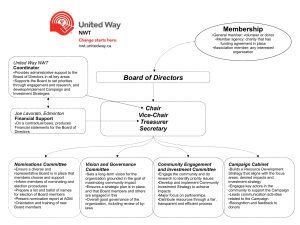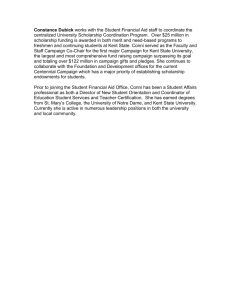Task – Species Conservation Campaign, student version
advertisement

Migration in the Balance A curriculum mini-unit addressing CT Science Standard 4.2 Task – Species Conservation Campaign The Task: There are lots of big changes taking place around the world. Some of these changes are natural, like earthquakes, and have been happening for millions of years. But these days, many of the changes we see are caused by humans – things like pollution, deforestation, climate change, and others. These human-caused changes affect many of the living organisms on Earth – sometimes directly (like destroying an animal’s home) and sometimes indirectly (like causing an animal’s main food source to go extinct). A very special group of animal species is heavily affected by these global changes – animals that migrate. Animals that migrate spend part of their life in one place and another part in a different place – sometimes the journey between these two places is long and dangerous. Some animals, including many birds, actually make these long journeys twice a year, for as long as they live. Their environment includes the places on both ends of their migration plus the path between, and major changes in any of these locations can make life extremely difficult for these animals. Your task, as a group, will be to choose one of the following ten migratory animal species and come up with a conservation campaign. You need to provide a convincing argument to the general public about why your species is at risk from one or more global changes, and why people should care and do something to help. A campaign can take many forms, but it should involve some type of marketing – a way of getting your message to the people you want to reach. This can include things like television, radio, social networks like Facebook and Twitter, brochures, posters, and articles or advertisements in newspapers and magazines. Your teacher may give you a budget – the amount of money you can spend on your campaign. If so, your teacher will also help you figure out the cost of these different types of marketing. The species: Atlantic Salmon Caribou Indiana bat Monarch butterfly North Atlantic right whale Osprey (bird) Polar Bear Red Knot (bird) Robin (bird) Spotted salamander There is a Discovery File for each of these ten species that should help answer some of the questions you will need to answer. However, you need to use at least two additional online resources given at the end of the Discovery File to answer the questions that are required of your role. Even the Marketing Director should find and study at least two outside resources, such as taking a look at a current media campaign to protect other animal species that may be in danger. The roles: Each member of the group will take on one of these roles – they represent real jobs in the real world, and the questions you need to answer will give you a sense of what these people do for their work. Please make sure you answer all of the questions completely – you will need to do some background research to accomplish this. Your final product should include written reports from the Wildlife Biologist, Environmental Scientist, and Conservationist, along with an outline of your campaign plan and all campaign documents from the Marketing Director. Wildlife Biologist Wildlife biologists STUDY wild animals. They try to learn everything about the animals and what they need. Guiding question: What does this animal need to have, and to do, in order to survive? Specific questions to answer: 1. 2. 3. 4. 5. 6. 7. 8. Where does your species live (both ends of the migration)? What is the habitat like in both places? How often does it migrate? What is the journey like, and where does it stop during its journey? What role does your species play in its ecosystems? Why is it important? And to what, or to whom, is it important? Which abiotic factors are important to your species? Where does it fit into the food web? Draw a food web with your species in it, showing the flow of energy from the sun to the top carnivores. See Discovery File on Food Chains and Food Webs if you need help. Environmental Scientist Environmental scientists STUDY pollution and other human-caused environmental problems. They figure out what is in the air, water, and soil to find out if the environment is safe for humans and other species. They mostly OBSERVE, but may also give advice on how to clean the environment. Guiding question: What are the most difficult human-caused challenges facing this species? Specific questions to answer: 1. What are the global changes (problems or challenges) facing your species, specifically those caused by humans? 2. How are these human-caused changes actually affecting the species? 3. Are the changes affecting your species directly, indirectly, or both? Give specific examples. 4. Would it be possible to stop these changes so that your species was not affected anymore? 5. If so, how would stopping the changes affect humans, particularly the humans involved in causing the changes in the first place? Conservationist Conservationists DEVELOP PLANS to help species. They often do this by making a plan to protect the land, water or air that a species depends upon. They use the work of wildlife biologists and environmental scientists to TAKE ACTION. Guiding question: What can be done to help this species overcome the human-caused challenges it faces? Specific questions to answer: 1. What is already being done (if anything) to help your species? (see, for example: http://www.defenders.org/north-atlantic-right-whale/successstories) 2. Are there any strategies that exist or have been proposed? 3. Think of ways to help your species survive if these global changes continue unchanged. 4. Think of ways of reducing the changes themselves. Marketing Director Marketing Directors DEVELOP PLANS to try to convince people to think a certain way about a topic or a product. Guiding question: How can you convince the public to care enough about this species in order to help save it? Specific questions to answer: 1. What is your public awareness campaign plan? (see, for example: http://www.ontarionature.org/protect/campaigns/woodland_caribou.p hp, especially the short video at the bottom of the page) 2. Who is your audience? 3. Lay out a detailed plan of action. 4. Write all necessary documents, using information gathered by your team members. 5. Find out the cost of what you are proposing, and keep your plan within the $2,000 budget. Make a list of everything that will cost money, and how much each of those will cost.








